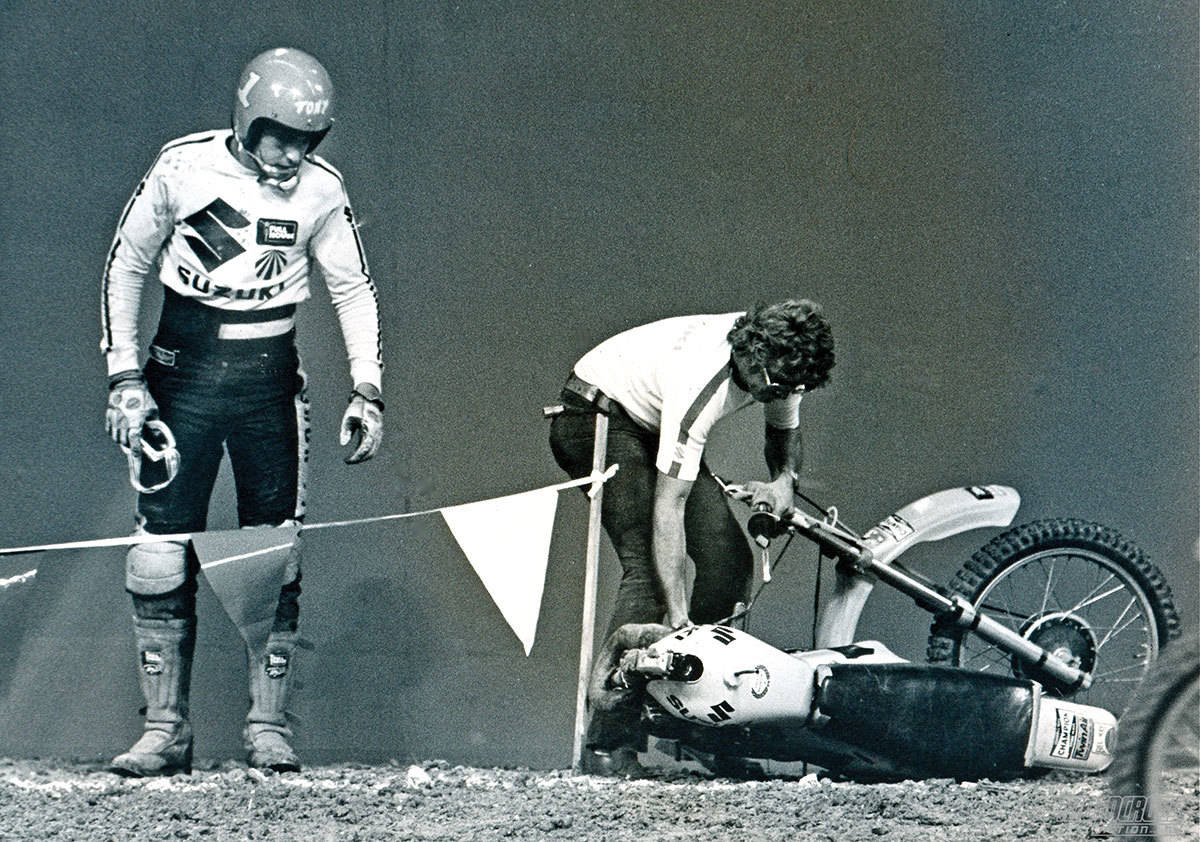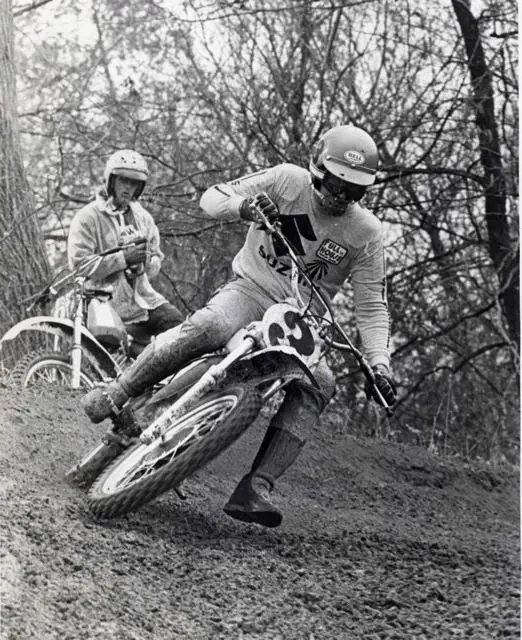FLASHBACK FRIDAY: THE NIGHT TONY D’S FORK BROKE OFF
 Tony DiStefano surveys the damage as Keith McCarty picks up the broken pieces. Note the blood running down Tony’s face.
Tony DiStefano surveys the damage as Keith McCarty picks up the broken pieces. Note the blood running down Tony’s face.
Perhaps the most spectacular series of mechanical failures in the sport happened to Team Suzuki over a five-month period from the 1975 Trans-AMA series to the 1976 AMA Supercross and National series. These weren’t blown engines or flat tires; these were major catastrophic failures. What made them even worse was that they kept happening.
At the 1975 Livermore Trans-AMA, Roger DeCoster’s triple clamps broke off as he landed over the biggest and fastest jump on the track. Roger flew face first into the dirt at 70 mph. A few months later, at the Gainesville round of the 1976 Florida Winter Series, Danny LaPorte’s Suzuki forks broke off when his triple clamps failed. Then, in front of a large crowd at the Dallas Supercross, Tony DiStefano’s forks snapped off his RM250 in spectacular fashion. All in all, there were four failures of the same part with three different riders in a six-race time period. What was going on?
We asked three-time AMA National Champion Tony D for his take on the triple-clamp fiasco. “When Roger broke his triple clamp at Livermore, the Suzuki engineers blamed it on the size of the jump. When Danny LaPorte’s triple clamps broke at the Florida Winter Series, Suzuki felt that the fork travel was too much and that this was increasing the leverage on the clamps. Additionally, Suzuki of Japan was blaming our mechanics, claiming that the mechanics were over-tightening the triple-clamp nut against the bearing. There were different steerer stems and clamps after each crash, but the forks just kept breaking off. For my part, after the forks had broken off twice, I assumed that Suzuki had gotten the message and we were safe for the 1976 AMA Supercross Championship.
“I thought I had the 1976 Supercross Championship in the bag. I was on a roll from my 1975 250 National Championship, Inter-AMA Championship and being first American in the Trans-AMA series. I won the first Supercross at Daytona and was second in the Astrodome. I was winning in Dallas when I came over that fateful jump. It felt like my handlebars had come loose, as the bars seemed to fall down. I was wrong. The front forks had broken off. It happened so fast that I didn’t know exactly what was going on. I hit the ground hard, and as I scrambled to my feet to pick my bike up, it was in two pieces. I was stunned, not just because I was bleeding from a cut on my face, but because the forks had broken off for the third time.
“I NEVER TRUSTED SUZUKI AGAIN, AND I MUST CONFESS THAT EVERY TIME I WENT TO THE STARTING LINE ON MY WAY TO THE 1976 AMA 250 NATIONAL CHAMPIONSHIP, I WAS AFRAID.”
“The medics came over and guided me to the ambulance, which was sitting behind the start line. The doctor said that I needed stitches, but I didn’t want to go to the hospital, so I had him stitch my face while I sat in the back of the ambulance and watched the race. A week later, Jody took the stitches out of my face with a pair of needle-nose pliers.
Suzuki was all apologetic because I had been leading the 1976 AMA Supercross Championship, which was only six races long, and it was all gone. They agreed to pay me my bonus. Supercross wasn’t as important back then as it is today. I was more focused on the Hangtown National opener, which was only three weeks away. We got another new steerer stem and, amazingly, Danny LaPorte’s forks broke again on his RM125 at Hangtown. I never trusted Suzuki again, and I must confess that every time I went to the starting line on my way to the 1976 AMA 250 National Championship, I was afraid.”







Comments are closed.